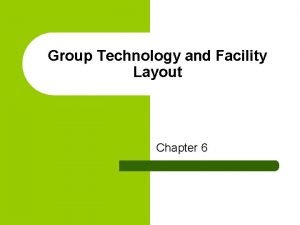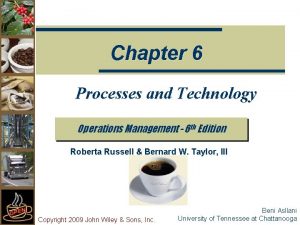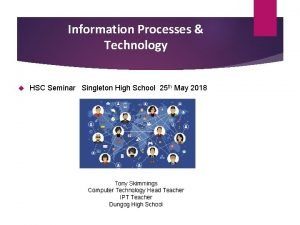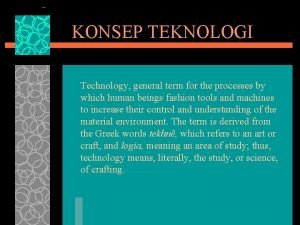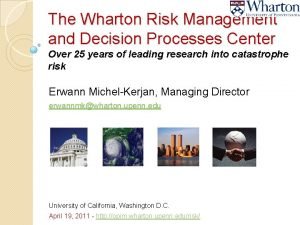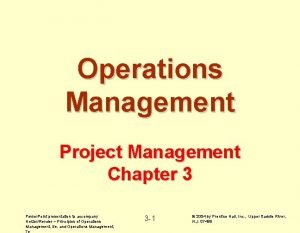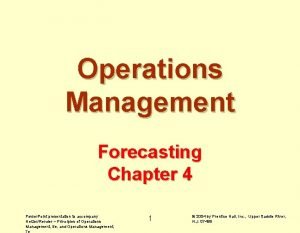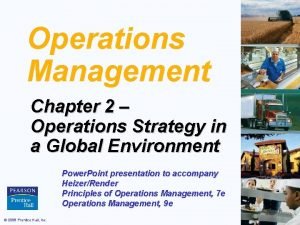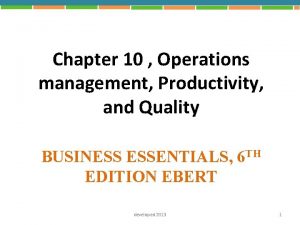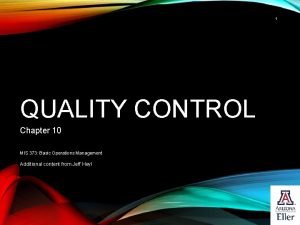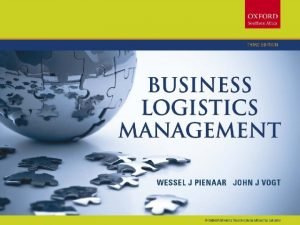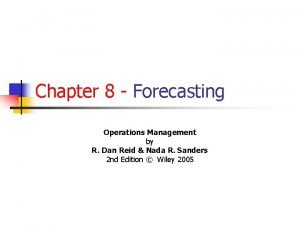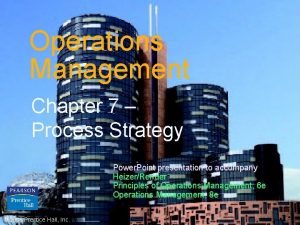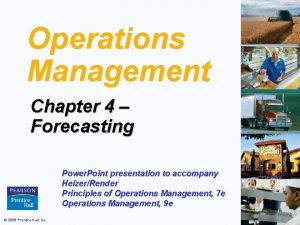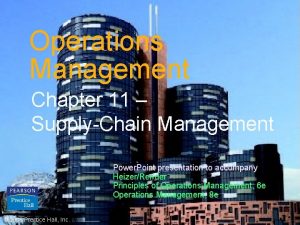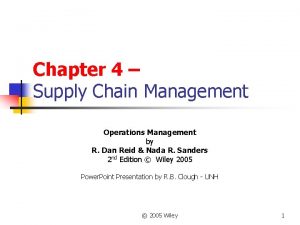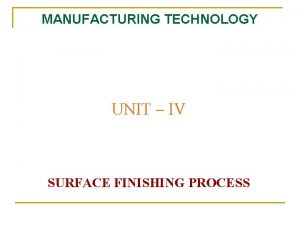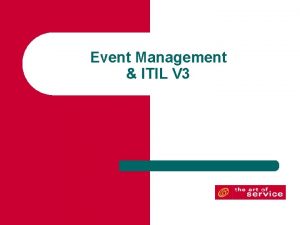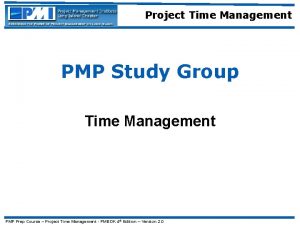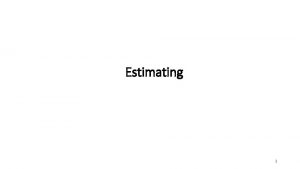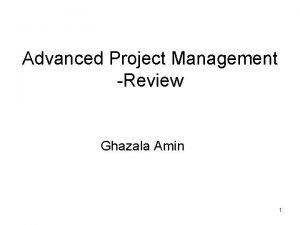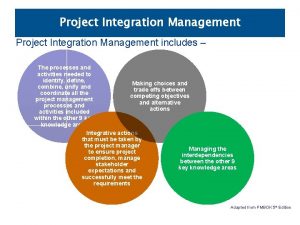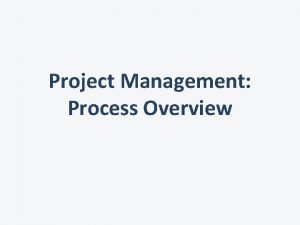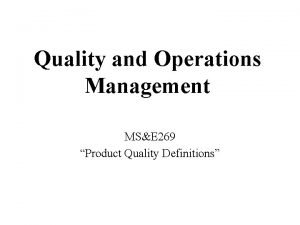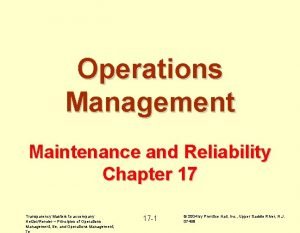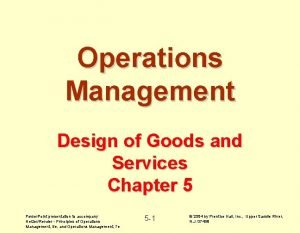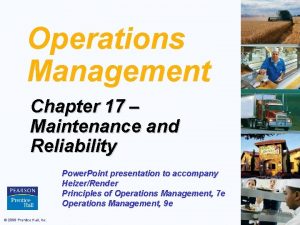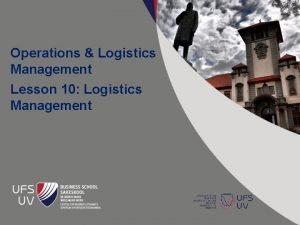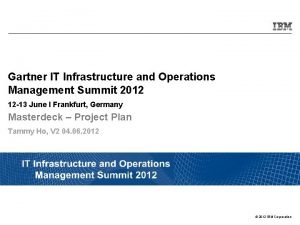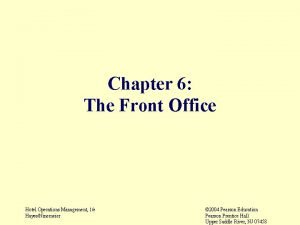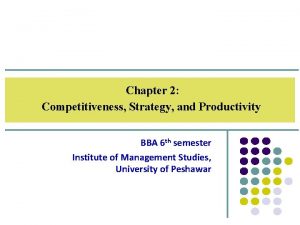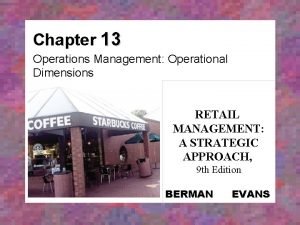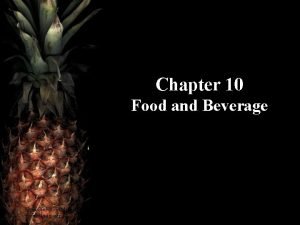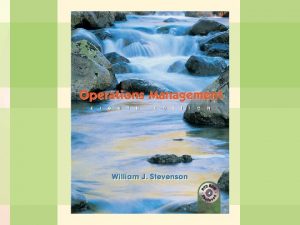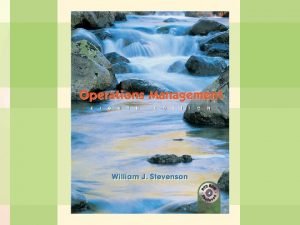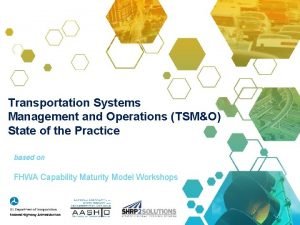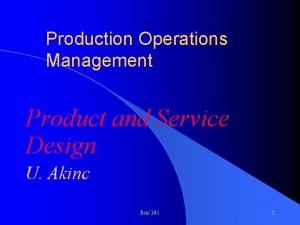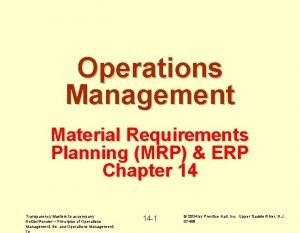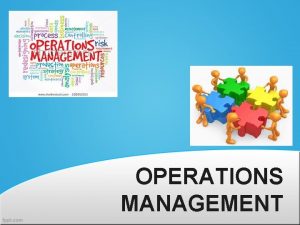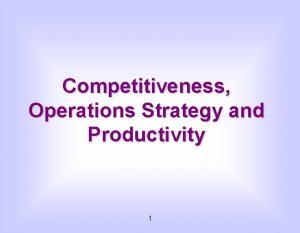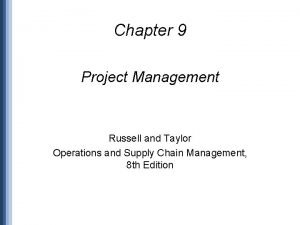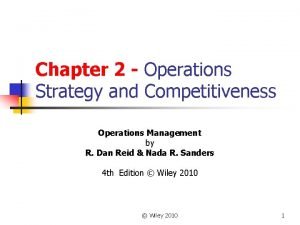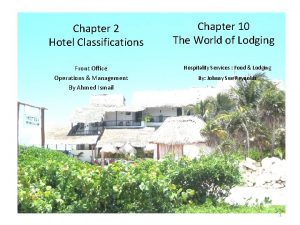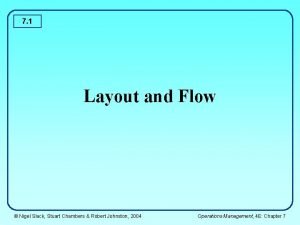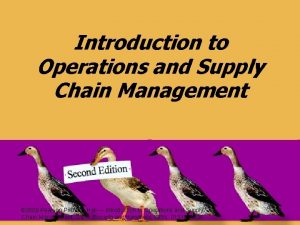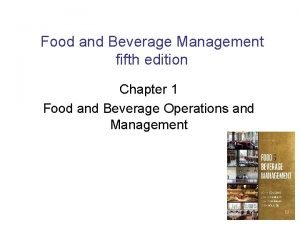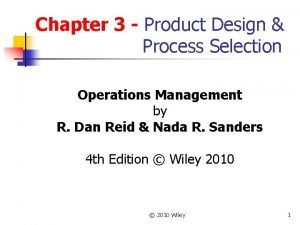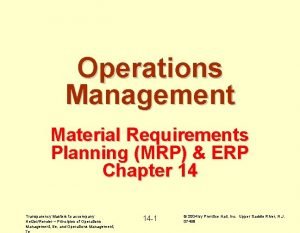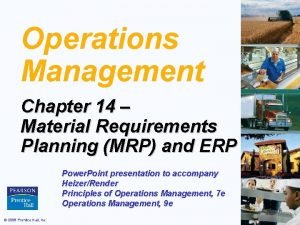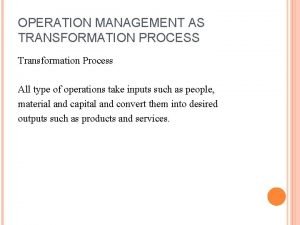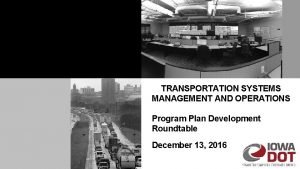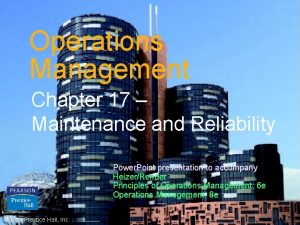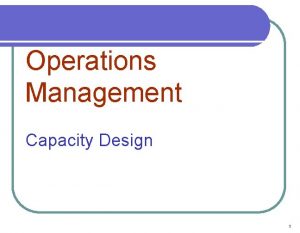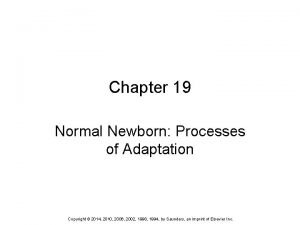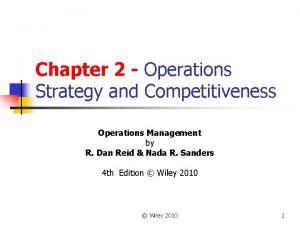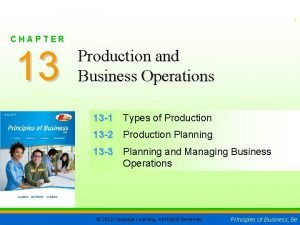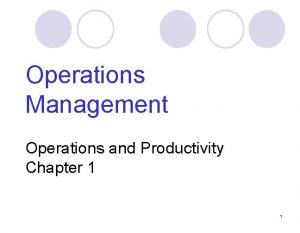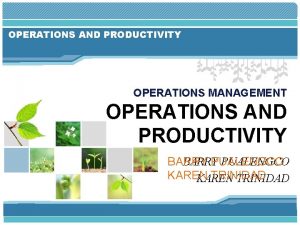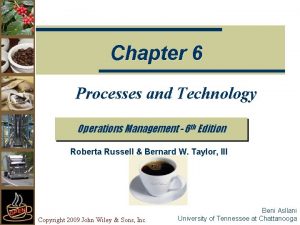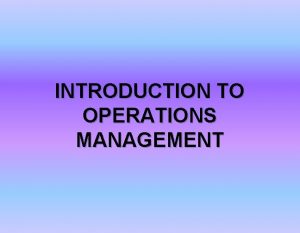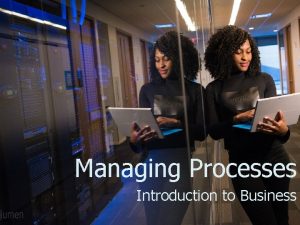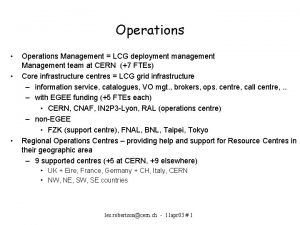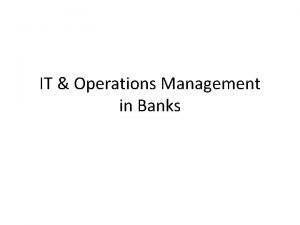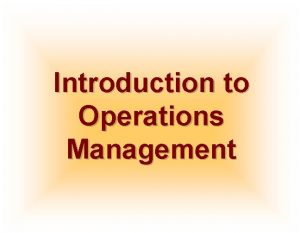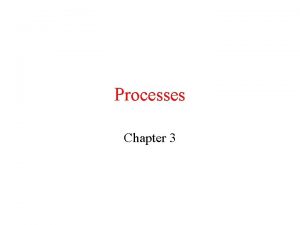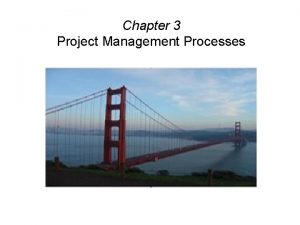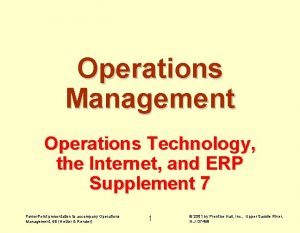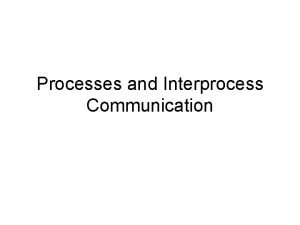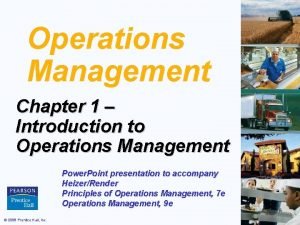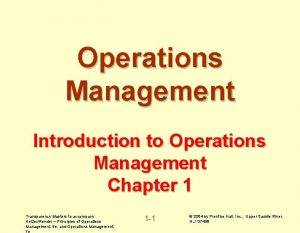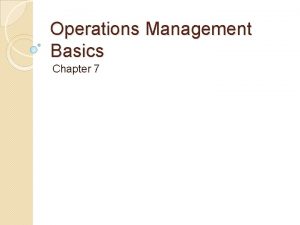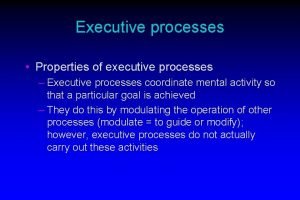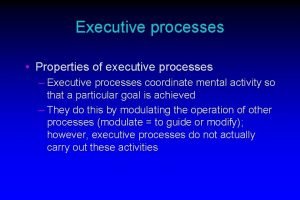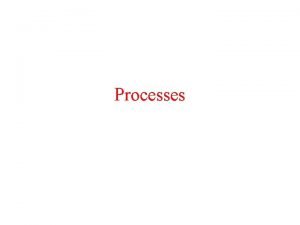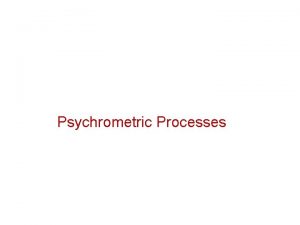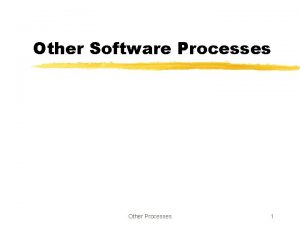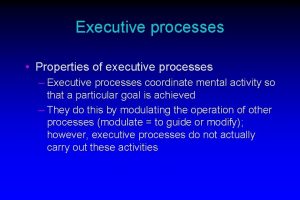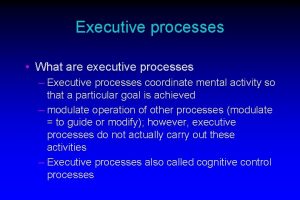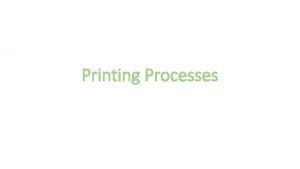Chapter 6 Processes and Technology Operations Management 6








































































- Slides: 72

Chapter 6 Processes and Technology Operations Management - 6 th Edition Roberta Russell & Bernard W. Taylor, III Copyright 2009 John Wiley & Sons, Inc. Beni Asllani University of Tennessee at Chattanooga

Relevant WEB Sites w Click Here Copyright 2006 John Wiley & Sons, Inc. 6 -2

1. Which of the following involves designing a product that can be produced easily? w w A. CPC (Collaborative Product Commerce) B. FMEA (Failure Mode and Effects Analysis) C. DFE (Design for Environment) D. DFM (Design for Manufacturing) Copyright 2006 John Wiley & Sons, Inc. 6 -3

w 2. ___________ refers to the ease with which a product can be repaired. w A. Reliability w B. Standardization w C. Maintainability w D. Modular production Copyright 2006 John Wiley & Sons, Inc. 6 -4

w 3. Which one of the following techniques improves product design by analyzing failures? n n A. QFD (Quality Function Deployment) B. FMEA (Failure Mode and Effects Analysis) C. VA (Value Analysis) D. DFM (Design For Manufacture) Copyright 2006 John Wiley & Sons, Inc. 6 -5

w 4. A complex computer program that tests and analyzes designs on the computer screen is called: w A. CAD (Computer-Aided Design). w B. CAM (Computer-Aided Manufacturing). w C. CIM (Computer Integrated Manufacturing). w D. CAE (Computer-Aided Engineering). Copyright 2011 John Wiley & Sons, Inc. 6 -6

w 5. Services are more __________ than products. w A. tangible w B. centralized w C. easily emulated w D. consistent Copyright 2006 John Wiley & Sons, Inc. 6 -7

w 6. A system consists of three elements in series, which have reliabilities of 0. 7, 0. 8, and 0. 9. The reliability of this system is: w A. 0. 800. w B. 2. 400. w C. 0. 900. w D. 0. 504. Copyright 2006 John Wiley & Sons, Inc. 6 -8

w 7. _________ yields a product or service designed to withstand variations in environmental and operating conditions. w A. Quality function deployment w B. Robust design w C. Computer aided design w D. Concurrent design Copyright 2006 John Wiley & Sons, Inc. 6 -9

8. The house of quality: w A. converts the voice of the customer into design technical requirements. w B. is one of the matrices used in quality function deployment. w C. does not produce an optimal solution. w D. All of the above. Copyright 2006 John Wiley & Sons, Inc. 6 -10

9. Good design practices include: w A. designing unique parts for each product. w B. simplifying operations. w C. using separate fasteners when possible. w D. All of the above. Copyright 2006 John Wiley & Sons, Inc. 6 -11

10. Collaborative design can take place: w A. between designers in the same company. w B. between manufacturers and suppliers. w C. between manufacturers and customers. w D. All of the above. Copyright 2006 John Wiley & Sons, Inc. 6 -12

Lecture Outline w Process Planning w Process Analysis w Process Innovation w Technology Decisions Copyright 2009 John Wiley & Sons, Inc. 6 -13

Process Planning w Process (Has to be defined first) n a group of related tasks with specific inputs and outputs w Process design n what tasks need to be done and how they are coordinated among functions, people, and organizations w Process strategy n an organization’s overall approach for physically producing goods and services w Process planning n converts designs into workable instructions for manufacture or delivery Copyright 2009 John Wiley & Sons, Inc. 6 -14

Process Strategy w Vertical integration n extent to which firm will produce inputs and control outputs of each stage of production process w Capital intensity n mix of capital (i. e. , equipment, automation) and labor resources used in production process w Process flexibility n ease with which resources can be adjusted in response to changes in demand, technology, products or services, and resource availability w Customer involvement n role of customer in production process Copyright 2009 John Wiley & Sons, Inc. 6 -15

Outsourcing w Cost w Capacity w Quality Copyright 2009 John Wiley & Sons, Inc. w Speed w Reliability w Expertise 6 -16

Process Selection w Projects n one-of-a-kind production of a product to customer order w Batch production n processes many different jobs at the same time in groups or batches w Mass production n produces large volumes of a standard product for a mass market w Continuous production n used for very-high volume commodity products Copyright 2009 John Wiley & Sons, Inc. 6 -17

Sourcing Continuum Copyright 2009 John Wiley & Sons, Inc. 6 -18

Product-Process Matrix Source: Adapted from Robert Hayes and Steven Wheelwright, Restoring the Competitive Edge Competing through Manufacturing (New York, John Wiley & Sons, 1984), p. 209. Copyright 2009 John Wiley & Sons, Inc. 6 -19

Types of Processes Type of product Type of customer Product demand PROJECT BATCH MASS CONT. Unique Made-to- order Made-to- stock Commodity (customized) (standardized ) Few individual customers Mass market Fluctuates Stable Very stable One-at-atime Infrequent Source: Adapted from R. Chase, N. Aquilano, and R. Jacobs, Operations Management for Competitive Advantage (New York: Mc. Graw-Hill, 2001), p. 210 Copyright 2009 John Wiley & Sons, Inc. 6 -20

Types of Processes (cont. ) PROJECT BATCH MASS CONT. Demand volume Very low Low to medium High Very high No. of different products Infinite variety Many, varied Few Very few Repetitive, assembly lines Continuous, process industries Production system Long-term Discrete, job project shops Source: Adapted from R. Chase, N. Aquilano, and R. Jacobs, Operations Management for Competitive Advantage (New York: Mc. Graw-Hill, 2001), p. 210 Copyright 2009 John Wiley & Sons, Inc. 6 -21

Types of Processes (cont. ) Equipment PROJECT BATCH MASS CONT. Varied Generalpurpose Specialpurpose Highly automated Assembly Mixing, treating, refining Limited range of skills Equipment monitors Specialized Primary Fabrication type of work contracts Worker skills Experts, craftspersons Wide range of skills Source: Adapted from R. Chase, N. Aquilano, and R. Jacobs, Operations Management for Competitive Advantage (New York: Mc. Graw-Hill, 2001), p. 210 Copyright 2009 John Wiley & Sons, Inc. 6 -22

Types of Processes (cont. ) PROJECT Advantages Disadvantages Examples BATCH MASS CONT. Custom work, latest technology Flexibility, quality Efficiency, speed, low cost Highly efficient, large capacity, ease of control Non-repetitive, small customer base, expensive Costly, slow, difficult to manage Construction, shipbuilding, spacecraft Machine shops, print shops, bakeries, education Capital Difficult to change, investment; far-reaching errors, lack of limited variety responsiveness Automobiles, televisions, computers, fast food Paint, chemicals, foodstuffs Source: Adapted from R. Chase, N. Aquilano, and R. Jacobs, Operations Management for Competitive Advantage (New York: Mc. Graw-Hill, 2001), p. 210 Copyright 2009 John Wiley & Sons, Inc. 6 -23

Process Selection with Break-Even Analysis w examines cost trade-offs associated with demand volume w Cost n Fixed costs l n constant regardless of the number of units produced Variable costs l vary with the volume of units produced w Revenue n price at which an item is sold w Total revenue n is price times volume sold w Profit n difference between total revenue and total cost Copyright 2009 John Wiley & Sons, Inc. 6 -24

Process Selection with Break-Even Analysis (cont. ) Total cost = fixed cost + total variable cost TC = cf + vcv Total revenue = volume x price TR = vp Profit = total revenue - total cost Z = TR – TC = vp - (cf + vcv) Copyright 2009 John Wiley & Sons, Inc. 6 -25

Process Selection with Break-Even Analysis (cont. ) TR = TC vp = cf + vcv vp - vcv = cf v(p - cv) = cf cf v= p-c v Solving for Break-Even Point (Volume) Copyright 2009 John Wiley & Sons, Inc. 6 -26

Break-Even Analysis: Example Fixed cost = cf = $2, 000 Variable cost = cv = $5 per raft Price = p = $10 per raft Break-even point is cf 2000 v = = 400 rafts p - cv 10 - 5 Copyright 2009 John Wiley & Sons, Inc. 6 -27

Break-Even Analysis: Graph Dollars Total cost line $3, 000 — $2, 000 — $1, 000 — Total revenue line 400 Break-even point Copyright 2009 John Wiley & Sons, Inc. Units 6 -28

Process Selection Process A Process B $2, 000 + $5 v = $10, 000 + $2 v $3 v = $8, 000 v = 2, 667 rafts Below 2, 667, choose A Above 2, 667, choose B Copyright 2006 John Wiley & Sons, Inc. 6 -29

Total cost of process A $20, 000 — Process Selection: Graph Total cost of process B $15, 000 — $10, 000 — Choose process A $5, 000 — | 1000 | 2000 Choose process B | 3000 | 4000 Units Point of indifference = 2, 667 Units Example 4. 2 Copyright 2006 John Wiley & Sons, Inc. 6 -30

Process Selection Process A Fixed cost Variable Cost Process B Process C 2000 1000 5 2 1 • At what point of indifference would a manager be indifferent to process A vs. process C? • At what point of indifference would a manager be indifferent to process B vs. process C Copyright 2006 John Wiley & Sons, Inc. 6 -31

Can build more sophisticated models with simulation w Learning curves built-in w Forecasting models built-in Copyright 2006 John Wiley & Sons, Inc. 6 -32

Process Plans w Set of documents that detail manufacturing and service delivery specifications n n n assembly charts operations sheets quality-control check-sheets Copyright 2009 John Wiley & Sons, Inc. 6 -33

Process Analysis • systematic examination of all aspects of process to improve operation Copyright 2009 John Wiley & Sons, Inc. 6 -34

An Operations Sheet for a Plastic Part name Crevice Tool Part No. 52074 Usage Hand-Vac Assembly No. 520 Oper. No. Description Dept. Machine/Tools Time 10 Pour in plastic bits 041 Injection molding 2 min 20 Insert mold 041 #076 2 min 30 Check settings & start machine 041 113, 67, 650 20 min 40 Collect parts & lay flat 051 Plastics finishing 10 min 50 Remove & clean mold 042 Parts washer 15 min 60 Break off rough edges 051 Plastics finishing 10 min Copyright 2009 John Wiley & Sons, Inc. 6 -35

Process Analysis w Building a flowchart n n n n Determine objectives Define process boundaries Define units of flow Choose type of chart Observe process and collect data Map out process Validate chart Copyright 2009 John Wiley & Sons, Inc. 6 -36

Process Flowcharts w look at manufacture of product or delivery of service from broad perspective w Incorporate n n nonproductive activities (inspection, transportation, delay, storage) productive activities (operations) Copyright 2009 John Wiley & Sons, Inc. 6 -37

Process analysis: must ask the question why 5 times w Why? n Why? l Why? w Why? § Why? w Why do we cut the wings off the turkey before broiling it, Mom? ? Copyright 2006 John Wiley & Sons, Inc. 6 -38

Process Flowchart Symbols Operations Inspection Transportation Delay Storage Copyright 2009 John Wiley & Sons, Inc. 6 -39

Process Flowchart of Apple Processing Copyright 2009 John Wiley & Sons, Inc. 6 -40

Process Flowchart of Apple Processing Description of process 1 Unload apples from truck 20 2 Apples peeled and cored 15 3 Soak in water until needed 20 4 Place in conveyor 5 5 Move to mixing area 6 Weigh, inspect, sort Page 1 0 f 3 Copyright 2006 John Wiley & Sons, Inc. Total Distance (feet) Location: Graves Mountain Process: Apple Sauce Time (min) Operation Transport Inspect Delay Storage Step Date: 9 -30 -02 Analyst: TLR 20 ft 30 480 190 ft 6 -41

Copyright 2009 John Wiley & Sons, Inc. 6 -42

Simple Value Chain Flowchart Copyright 2009 John Wiley & Sons, Inc. 6 -43

Process Innovation Continuous improvement refines the breakthrough Breakthrough Improvement Total redesign of a process for breakthrough improvements Copyright 2009 John Wiley & Sons, Inc. Continuous improvement activities peak; time to reengineer process 6 -44

From Function to Process Sales Manufacturing Purchasing Accounting Product Development Order Fulfillment Supply Chain Management Customer Service Function Copyright 2009 John Wiley & Sons, Inc. Process 6 -45

Process Innovation Customer Requirements Strategic Directives Goals for Process Performance High - level Process map Innovative Ideas Detailed Process Map Model Validation Pilot Study of New Design No Baseline Data Benchmark Data Goals Met? Copyright 2009 John Wiley & Sons, Inc. Yes Design Principles Key Performance Measures Full Scale Implementation 6 -46

High-Level Process Map Copyright 2009 John Wiley & Sons, Inc. 6 -47

Principles for Redesigning Processes w Remove waste, simplify, and consolidate similar activities w Link processes to create value w Let the swiftest and most capable enterprise execute the process w Flex process for any time, any place, any way w Capture information digitally at the source and propagate it through process Copyright 2009 John Wiley & Sons, Inc. 6 -48

Principles for Redesigning Processes (cont. ) w Provide visibility through fresher and richer information about process status w Fit process with sensors and feedback loops that can prompt action w Add analytic capabilities to process w Connect, collect, and create knowledge around process through all who touch it w Personalize process with preferences and habits of participants Copyright 2009 John Wiley & Sons, Inc. 6 -49

Techniques for Generating Innovative Ideas w Vary the entry point to a problem n in trying to untangle fishing lines, it’s best to start from the fish, not the poles w Draw analogies n a previous solution to an old problem might work w Change your perspective n n think like a customer bring in persons who have no knowledge of process Copyright 2009 John Wiley & Sons, Inc. 6 -50

Techniques for Generating Innovative Ideas (cont. ) w Try inverse brainstorming n n what would increase cost what would displease the customer w Chain forward as far as possible n if I solve this problem, what is the next problem w Use attribute brainstorming n how would this process operate if. . . l l l our workers were mobile and flexible there were no monetary constraints we had perfect knowledge Copyright 2009 John Wiley & Sons, Inc. 6 -51

Principles of BPR (Business Process Reengineering) w Processes differ by the type of job being processed n Not just one process but many are employed depending on the size of the job w Work is performed where it makes the most sense n Wal-Mart moves the replenishment function to its suppliers w Eliminate handoffs Copyright 2006 John Wiley & Sons, Inc.

Principles of BPR, Cont’d w Reconciliation is minimized w A case manager provides a single point of contact w Hybrid centralized/decentralized operations are prevalent n IT enables decisions to operate autonomously Copyright 2006 John Wiley & Sons, Inc.

Benefits of elimination of handoffs w No transits w No waiting for another operator w No waiting in queues w No setups w No supervision/coordination required Copyright 2006 John Wiley & Sons, Inc.

TASKS of the Re-engineering team w 1) determine measures of performance w 2) install measures of performance w 3) delineate entire existing process in all its gory detail w 4) perform process value analysis and activity-based costing w 5) benchmark processes by comparison with other processes Copyright 2006 John Wiley & Sons, Inc.

TASKS of the Re-engineering team, Cont’d w w w 6) design re-invented process 7) simulate re-invented process 8) prepare report with recommendations 9) install re-invented process 10) measure improvements Copyright 2006 John Wiley & Sons, Inc.

Technology Decisions w Financial justification of technology n n n n Purchase cost Operating Costs Annual Savings Revenue Enhancement Replacement Analysis Risk and Uncertainty Piecemeal Analysis Copyright 2009 John Wiley & Sons, Inc. 6 -57

Components of e-Manufacturing Copyright 2009 John Wiley & Sons, Inc. 6 -58

Principles of good process design w Start with a vision w Decide upon approach w As few people as possible involved in the final process w Lots of involvement, empowerment and ownership Copyright 2006 John Wiley & Sons, Inc.

Principles of good process design, Cont’d w Simplicity, simplicity w Make it fun, make it easy w Focus on outcomes n n Shortened cycle times Lower cost Higher quality Higher throughput w Simulate the prototype Copyright 2006 John Wiley & Sons, Inc.

BPR (and INNOVATION) VS PROCESS IMPROVEMENT w IMPROVEMENT w w w w w Level of change Starting point Freq of change Time required Participation Typical scope Risk Primary enabler Type of change Incremental Existing process Continuous short bottom-up Narrow Moderate Statistical control cultural Copyright 2006 John Wiley & Sons, Inc. BUS PROCESS REENG (Innovation) Radical Clean slate One-time long top-down Broad High Information technology cultural / structural 6 -61

Process Innovation Continuous improvement refines the breakthrough Breakthrough Innovation Total redesign of a process for breakthrough innovations Copyright 2006 John Wiley & Sons, Inc. Continuous improvement activities peak; time to reengineer process 6 -62

Components of e-Manufacturing Copyright 2006 John Wiley & Sons, Inc. 6 -63

A Technology Primer Product Technology w Computer-aided design (CAD) w Group technology (GT) w Computer-aided engineering (CAE) w Collaborative product commerce (CPC) w Creates and communicates designs electronically w Classifies designs into families for easy retrieval and modification w Tests functionality of CAD designs electronically w Facilitates electronic communication and exchange of information among designers and suppliers Copyright 2009 John Wiley & Sons, Inc. 6 -64

A Technology Primer (cont. ) Product Technology w Product data management (PDM) w Product life cycle management (PLM) w Product configuration w Keeps track of design specs and revisions for the life of the product w Integrates decisions of those involved in product development, manufacturing, sales, customer service, recycling, and disposal w Defines products “configured” by customers who have selected among various options, usually from a Web site Copyright 2009 John Wiley & Sons, Inc. 6 -65

A Technology Primer (cont. ) Process Technology w Standard for exchange of product model data (STEP) w Computer-aided design and manufacture (CAD/CAM) w Computer aided process (CAPP) w E-procurement w Set standards for communication among different CAD vendors; translates CAD data into requirements for automated inspection and manufacture w Electronic link between automated design (CAD) and automated manufacture (CAM) w Generates process plans based on database of similar requirements w Electronic purchasing of items from emarketplaces, auctions, or company websites Copyright 2009 John Wiley & Sons, Inc. 6 -66

A Technology Primer (cont. ) Manufacturing Technology w Computer w Machines controlled by software code to perform a numerically control variety of operations with the help of automated (CNC) tool changers; also collects processing information w Flexible manufacturing system (FMS) w Robots w Conveyors and quality data w A collection of CNC machines connected by an automated material handling system to produce a wide variety of parts w Manipulators that can be programmed to perform repetitive tasks; more consistent than workers but less flexible w Fixed-path material handling; moves items along a belt or overhead chain; “reads” packages and diverts them to different directions; can be very fast Copyright 2009 John Wiley & Sons, Inc. 6 -67

A Technology Primer (cont. ) Manufacturing Technology w Automatic guided vehicle (AGV) w A driverless truck that moves material along a specified path; directed by wire or tape embedded in floor or by radio frequencies; very flexible w Automated storage w An automated warehouse—some 26 stores high— in which items are placed in a carousel-type and retrieval system storage system and retrieved by fast-moving (ASRS) stacker cranes; controlled by computer w Process Control w Continuous monitoring of automated equipment; makes real-time decisions on ongoing operation, maintenance, and quality w Computer-integrated w Automated manufacturing systems integrated through computer technology; also called emanufacturing (CIM) manufacturing Copyright 2009 John Wiley & Sons, Inc. 6 -68

A Technology Primer (cont. ) Information Technology w Business – to – Business (B 2 B) w Business – to – Consumer (B 2 C) w Internet w Electronic transactions between businesses usually over the Internet w Intranet w Communication networks internal to an organization; can be password (i. e. , firewall) protected sites on the Internet w Extranet w Electronic transactions between businesses and their customers usually over the Internet w A global information system of computer networks that facilitates communication and data transfer w Intranets connected to the Internet for shared access with select suppliers, customers, and trading partners Copyright 2009 John Wiley & Sons, Inc. 6 -69

A Technology Primer (cont. ) Information Technology w Bar Codes w w Radio Frequency Identification tags (RFID) w w Electronic data interchange (EDI) w Extensive markup language (XML) w w Enterprise resource planning (ERP) A series of vertical lines printed on most packages that identifies item and other information when read by a scanner An integrated circuit embedded in a tag that can send and receive information; a twenty-first century bar code with read/write capabilities A computer-to-computer exchange of business documents over a proprietary network; very expensive and inflexible A programming language that enables computer – to - computer communication over the Internet by tagging data before its is sent Software for managing basic requirements of an enterprise, including sales & marketing, finance and accounting, production & materials management, and human resources Copyright 2009 John Wiley & Sons, Inc. 6 -70

A Technology Primer (cont. ) Information Technology w Supply chain management (SCM) w Customer relationship management (CRM) w w Decision support systems (DSS) w Expert systems (ES) w Artificial intelligence (AI) w w Software for managing flow of goods and information among a network of suppliers, manufacturers and distributors Software for managing interactions with customers and compiling and analyzing customer data An information system that helps managers make decisions; includes a quantitative modeling component and an interactive component for what-if analysis A computer system that uses an expert knowledge base to diagnose or solve a problem A field of study that attempts to replicate elements of human thought in computer processes; includes expert systems, genetic algorithms, neural networks, and fuzzy logic Copyright 2009 John Wiley & Sons, Inc. 6 -71

Copyright 2009 John Wiley & Sons, Inc. All rights reserved. Reproduction or translation of this work beyond that permitted in section 117 of the 1976 United States Copyright Act without express permission of the copyright owner is unlawful. Request for further information should be addressed to the Permission Department, John Wiley & Sons, Inc. The purchaser may make back-up copies for his/her own use only and not for distribution or resale. The Publisher assumes no responsibility for errors, omissions, or damages caused by the use of these programs or from the use of the information herein. Copyright 2009 John Wiley & Sons, Inc. 6 -72
 Concurrent in os
Concurrent in os Operations management chapter 12 inventory management
Operations management chapter 12 inventory management Group technology layout in operations management
Group technology layout in operations management Process technology in operations management
Process technology in operations management Information processes and technology past papers
Information processes and technology past papers Konsep teknologi
Konsep teknologi Quality management in operations management
Quality management in operations management What is tqm
What is tqm Wharton risk management and decision processes center
Wharton risk management and decision processes center Operation management chapter 3
Operation management chapter 3 Operations management chapter 4 forecasting solutions
Operations management chapter 4 forecasting solutions Operation management chapter 2
Operation management chapter 2 Chapter 1 operations management
Chapter 1 operations management Product design process in operations management
Product design process in operations management Operations management chapter 10
Operations management chapter 10 Asq control chart
Asq control chart Chapter 8 operations management
Chapter 8 operations management Forecasting
Forecasting Four process strategies in operations management
Four process strategies in operations management Operations management chapter 4
Operations management chapter 4 Chapter 11 operations management
Chapter 11 operations management Job design continuum
Job design continuum 4 flows of supply chain
4 flows of supply chain Competitive operations strategy
Competitive operations strategy Cylindrical grinding machine
Cylindrical grinding machine Types of jaycustomers
Types of jaycustomers Activities in event management
Activities in event management Project time management processes
Project time management processes Pmbok cost management
Pmbok cost management Project management processes
Project management processes Project integration management
Project integration management Six processes of project integration management
Six processes of project integration management A process consists of one or more
A process consists of one or more Mse operations management
Mse operations management Maintenance and reliability in operations management
Maintenance and reliability in operations management Design of goods and services
Design of goods and services Maintenance and reliability in operations management
Maintenance and reliability in operations management Introduction to operations and supply chain management
Introduction to operations and supply chain management Gartner portfolio management summit
Gartner portfolio management summit Management issues central to strategy implementation
Management issues central to strategy implementation Implementing strategies management and operations issues
Implementing strategies management and operations issues Chapter 7 strategic management
Chapter 7 strategic management Bucket check in front office
Bucket check in front office Labor productivity example
Labor productivity example Retail management and operations
Retail management and operations Food and beverage operations management
Food and beverage operations management Location planning and analysis
Location planning and analysis Mrp 1 in operations management
Mrp 1 in operations management Transportation systems management and operations
Transportation systems management and operations Product and service design
Product and service design Mrp table
Mrp table Operations management functions
Operations management functions What is the strategic plan and analysis of retailing?
What is the strategic plan and analysis of retailing? Operations strategy and competitiveness
Operations strategy and competitiveness Russell and taylor operations management
Russell and taylor operations management Productivity and competitiveness in operations management
Productivity and competitiveness in operations management Amenities and facilities difference
Amenities and facilities difference Layout and flow operations management
Layout and flow operations management Introduction to operations and supply chain management
Introduction to operations and supply chain management The four realms of experience
The four realms of experience Process selection types
Process selection types Erp in operations management
Erp in operations management Mrp operations
Mrp operations Operations transformation process
Operations transformation process Strategic business unit structure
Strategic business unit structure Transportation systems management and operations
Transportation systems management and operations Maintenance and reliability in operations management
Maintenance and reliability in operations management Design capacity in operations management
Design capacity in operations management Implementing strategies management and operations issues
Implementing strategies management and operations issues Chapter 19 normal newborn processes of adaptation
Chapter 19 normal newborn processes of adaptation Chapter 2 operations strategy and competitiveness
Chapter 2 operations strategy and competitiveness Chapter 13 production and business operations
Chapter 13 production and business operations Operation and productivity chapter 1
Operation and productivity chapter 1


